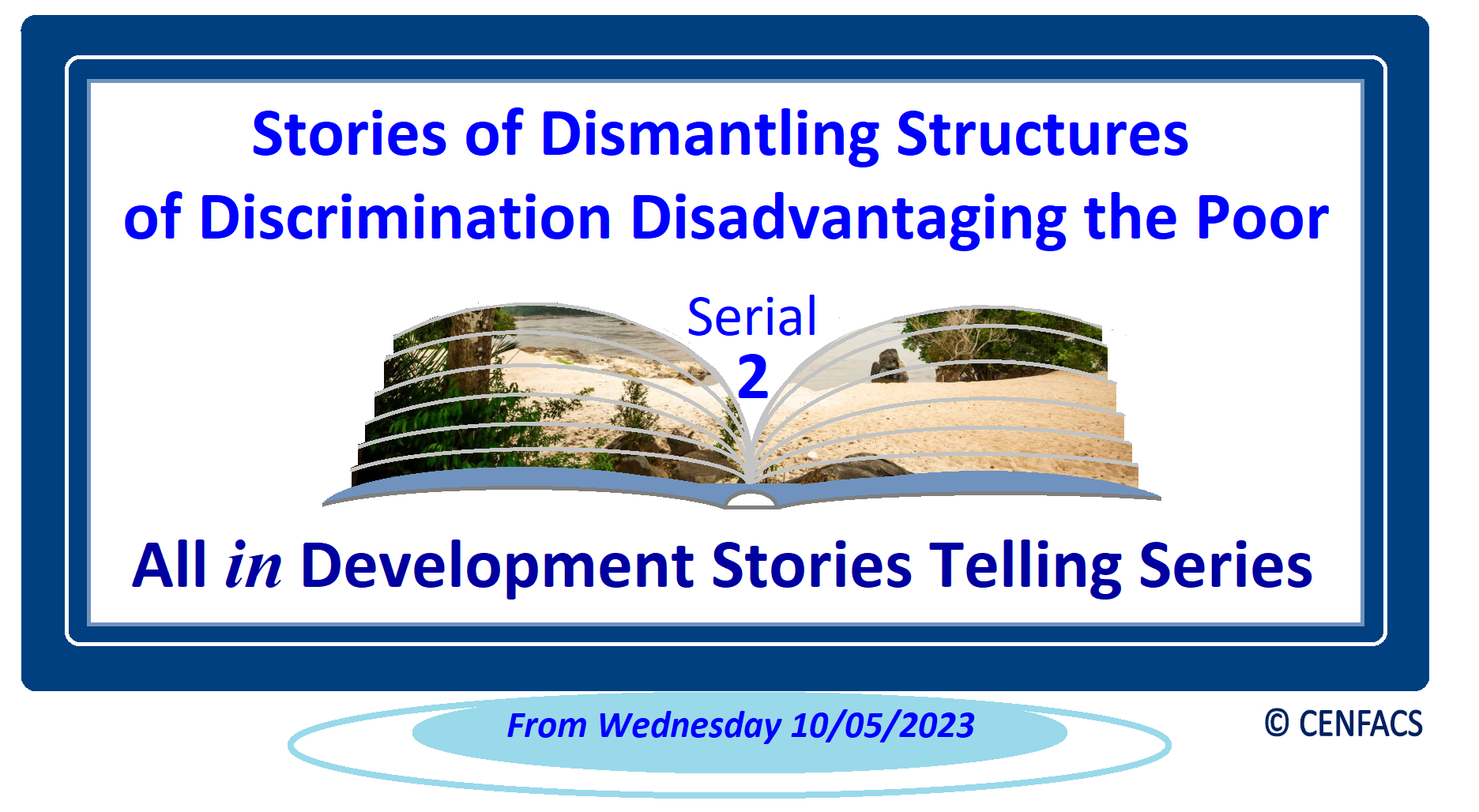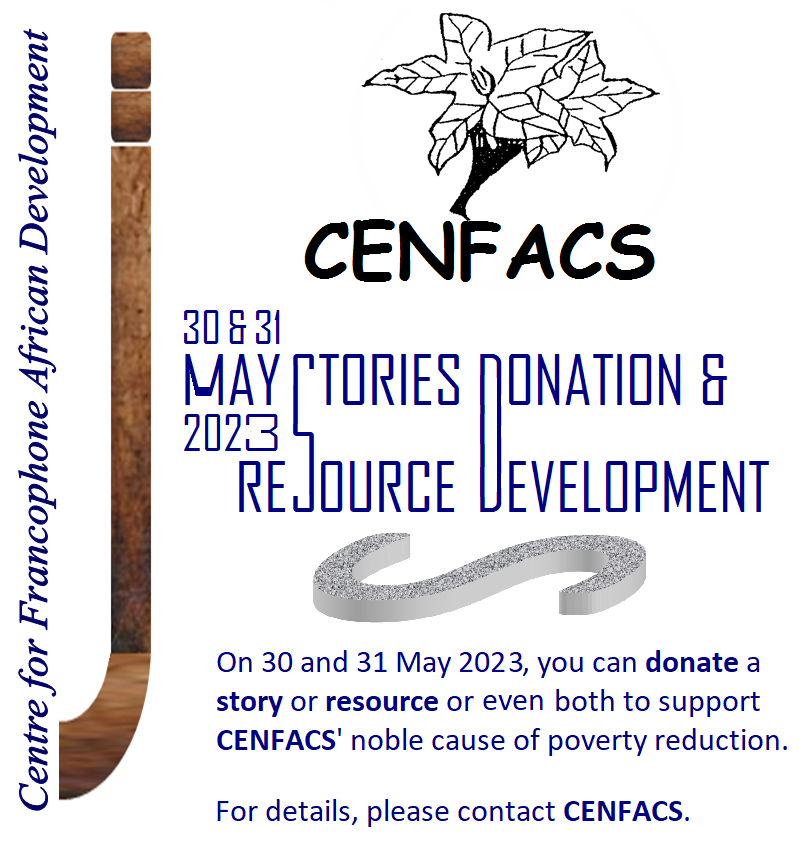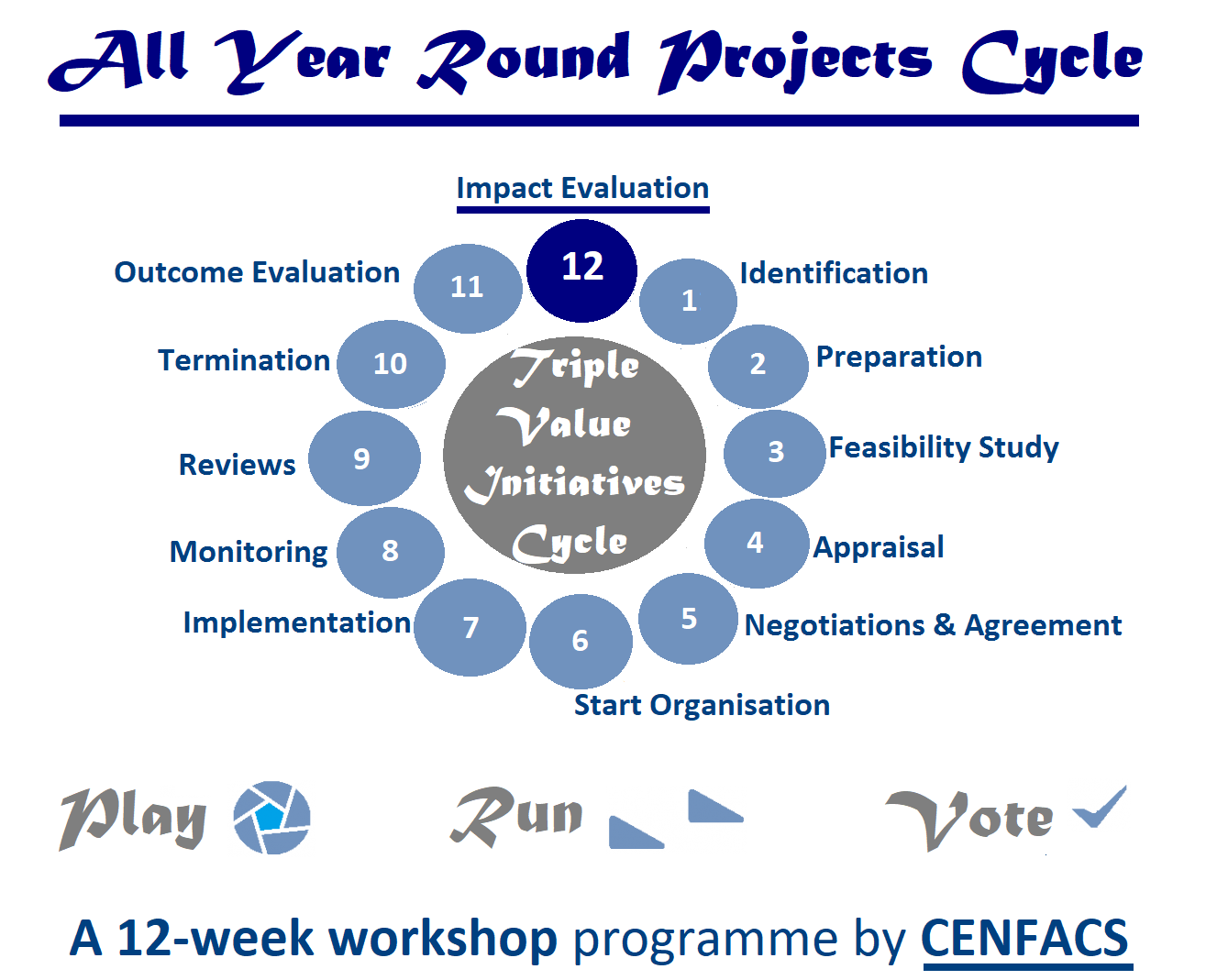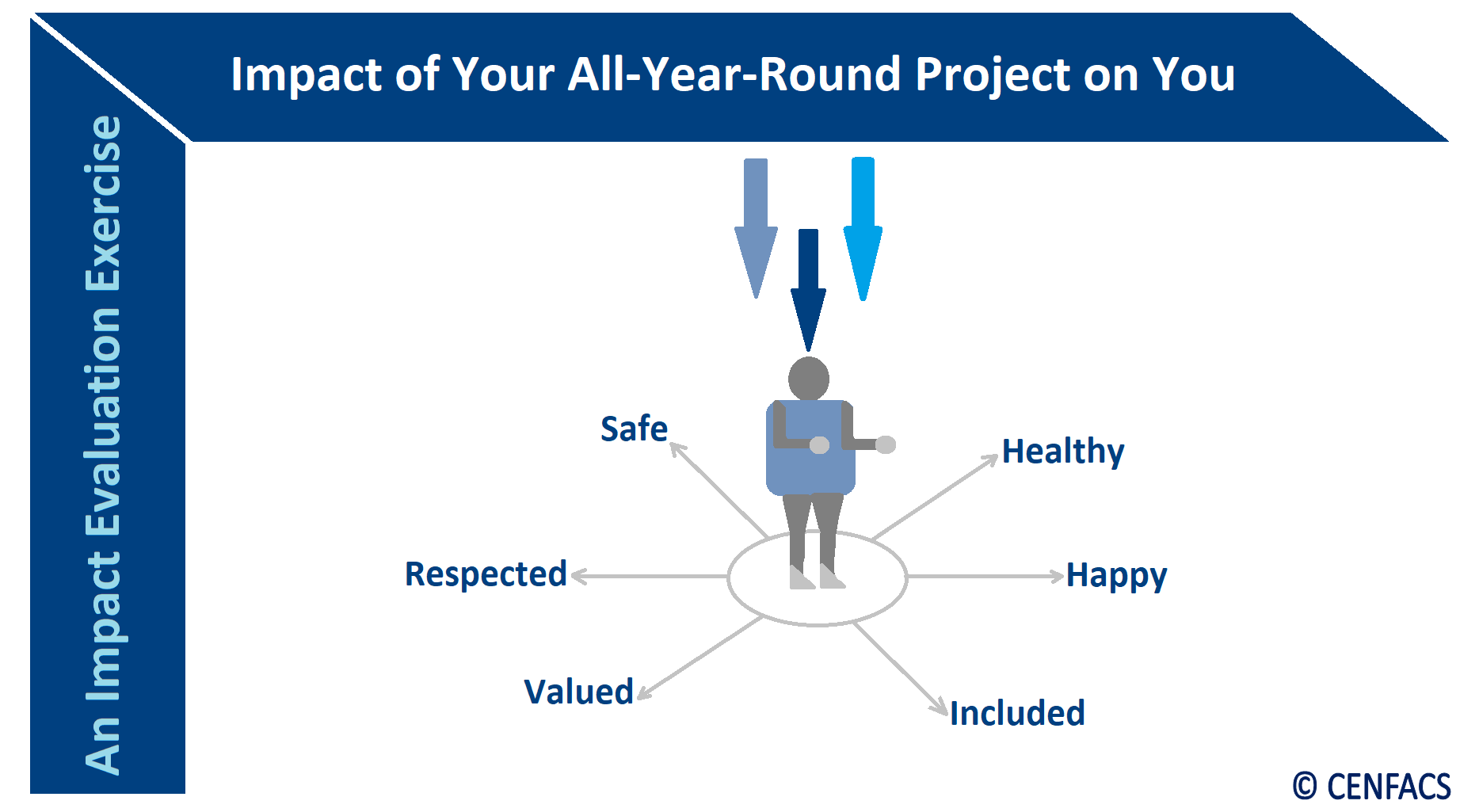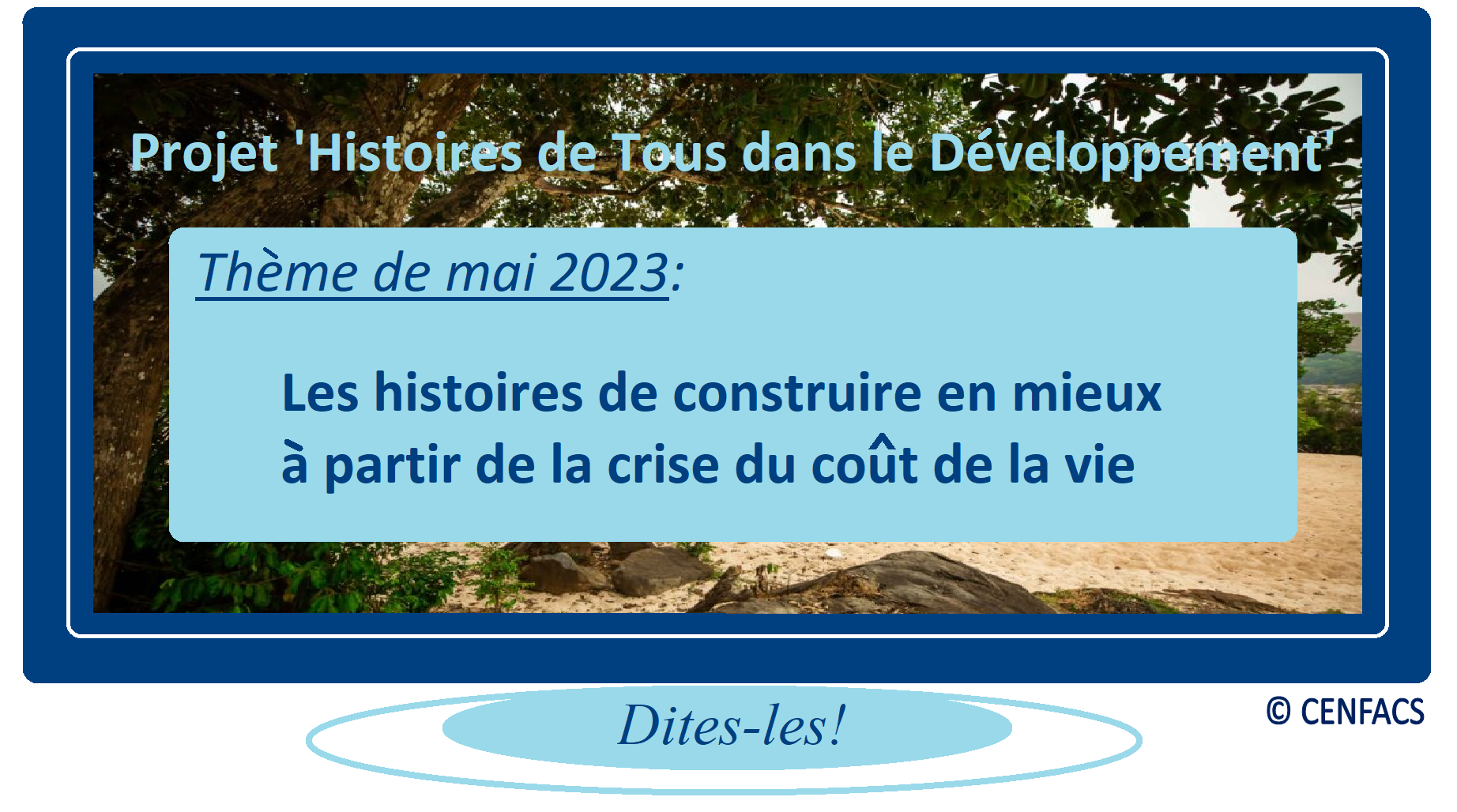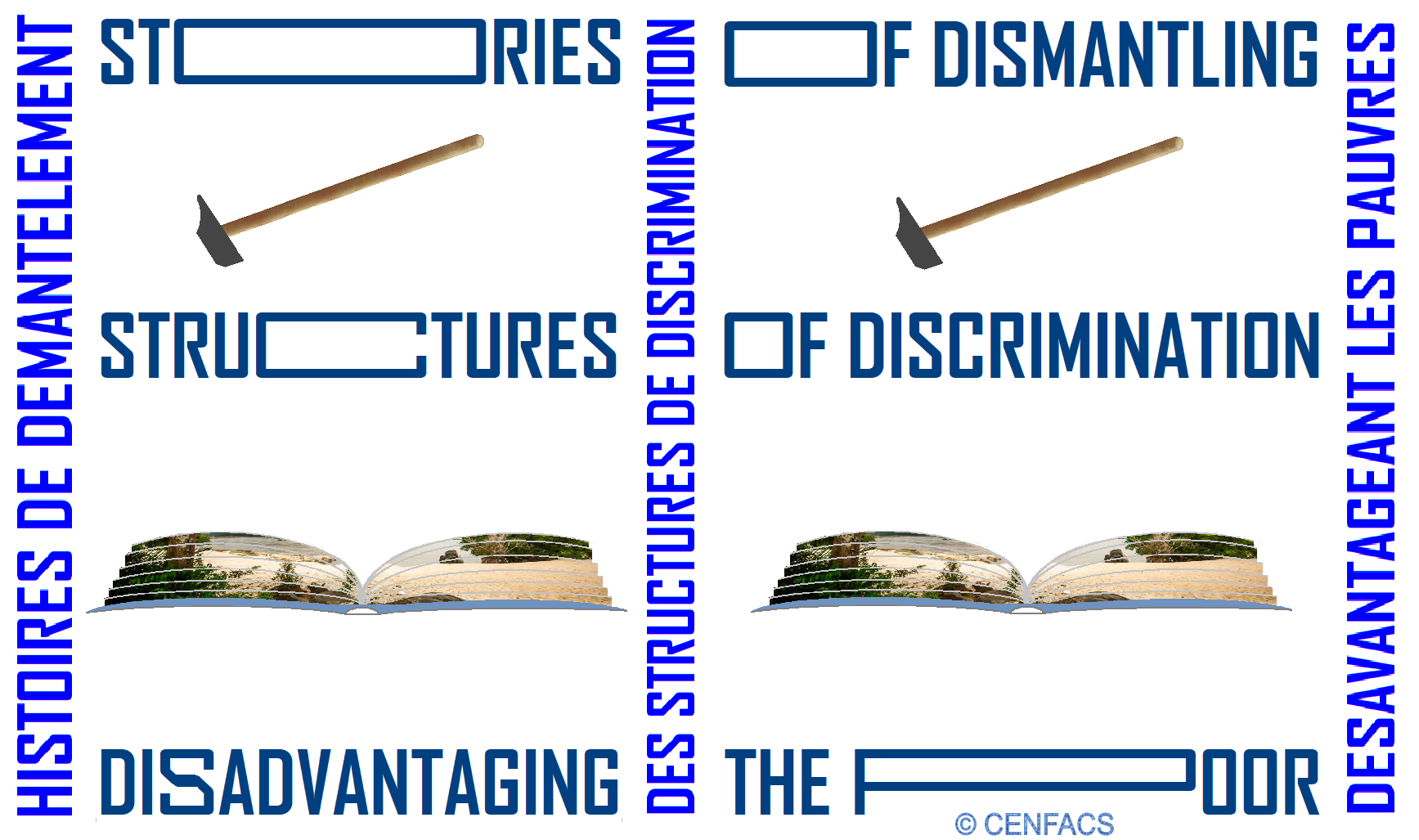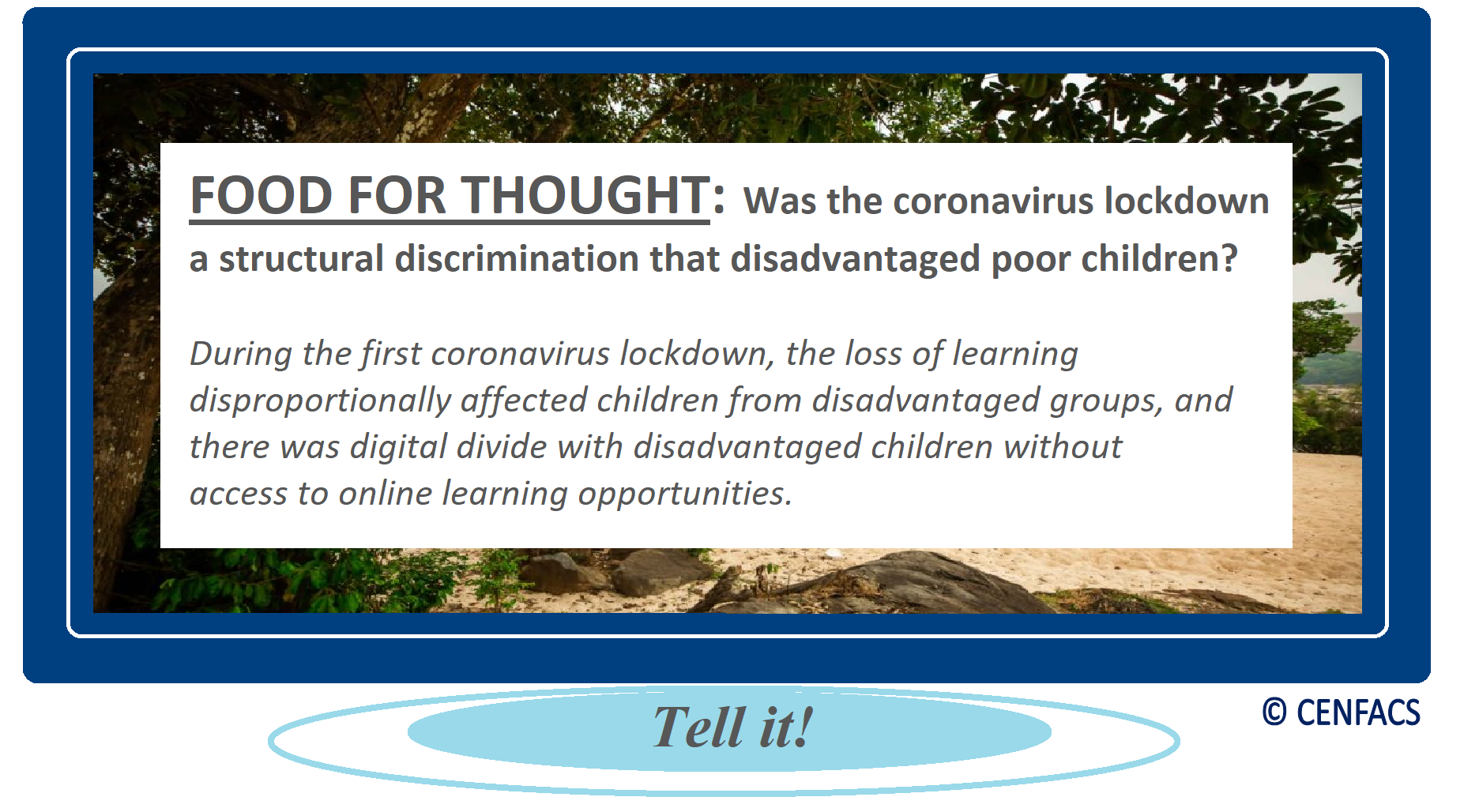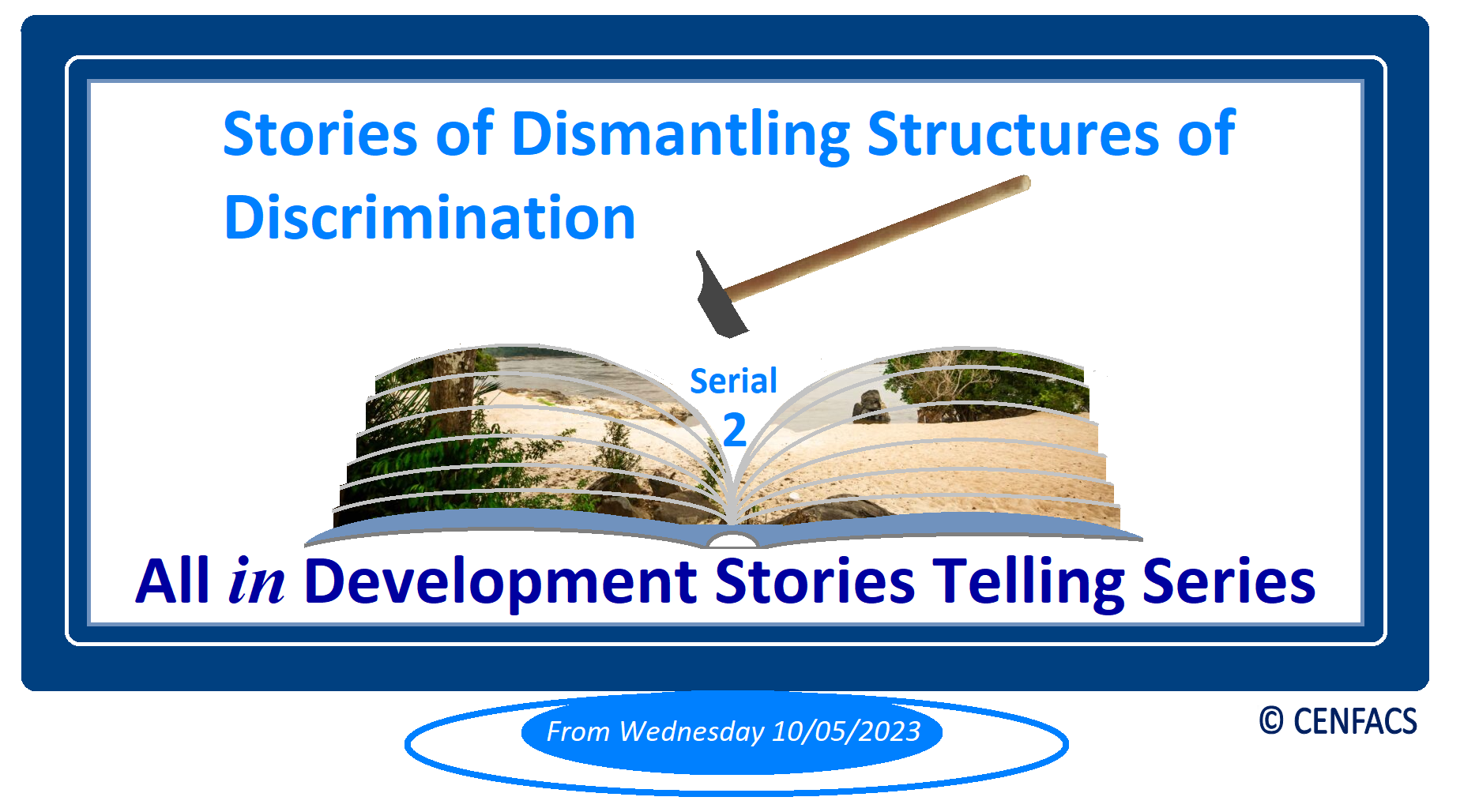Welcome to CENFACS’ Online Diary!
10 May 2023
Post No. 299
The Week’s Contents
• All in Development Stories Serial 2: Stories of Dismantling Structures of Discrimination Disadvantaging the Poor (Starting from Wednesday 10/05/2023)
• Goal of the Month: Make Poverty Reduction through Stories
• All-year Round Projects Cycle (Triple Value Initiatives Cycle) – Step/Workshop 12: Impact Evaluating Your Play, Run and Vote Projects
… And much more!
Key Messages
• All in Development Stories Serial 2: Stories of Dismantling Structures of Discrimination Disadvantaging the Poor (Starting from Wednesday 10/05/2023)
Stories of Dismantling Structures of Discrimination Disadvantaging the Poor are the tales of demolition of the building or fabric of discrimination that holds back those in need or exacerbate poverty. To understand and better share these tellings, one may need to know the structures of discrimination they want to be dismantled. It could also be interesting to find out that after dismantling these structures, how this dismantling result is going to help the poor. In other words, it is not enough to argue for dismantling discrimination structures. To complete the work, one needs to explain how this is going to support the poor. Completing the work in this way can also provides opportunity to those (the poor) who benefited from the dismantling process of discrimination structures to provide their stories of benefit from the result of this process.
Additionally, it could be helpful to explore the relationship that may exist between dismantled discrimination and poverty reduction since we are dealing the poor. Learning and knowing this relationship can make easy to explain people, in particular but not exclusively the members of the CENFACS Community, why it is important for them to provide stories, if they have any, on the matter of dismantled discrimination and disadvantage filling gap matters. This learning and knowledge will better contribute to stories donation as giving a story for them will be more than just narrating their accounts. It will be about empowering them from the spaces and opportunities they can seize from dismantled structures of discrimination.
More about the stories of dismantling structures of discrimination disadvantaging the poor is given under the Main Development section of this post.
• Goal of the Month: Make Poverty Reduction through Stories
Our poverty reduction goal for May 2023 is Making Poverty Reduction Happen through Stories. It is about telling and sharing stories that can pitch or lead to poverty reduction and sustainable development for the poor and those CENFACS Community members who may need inspiring and motivational stories to find their ways out the problems they have. In other words, by listening, viewing and learning from inspiring stories they can develop their own strengths to gradually find their own pace and tune towards the reduction of poverty and sustainable development.
To put this into perspective, Pullanikkatil and Shackleton (1) give the example of Poverty Reduction through Non-Timber Forest Products. Referring to the work of Pullanikkatil and Shackleton, Sarah Feder (2) explains that
“Stories can amplify the voices of people who are not often heard, and make their experiences relatable to people in wildly different contexts”.
Likewise, Angela Wood and John Barnes (3) are in favour of
“Amplifying poor people’s voices by combining alternative media such as community radio, oral testimonies and community theatre with the involvement of the media”.
It is possible to deduct from these two quotations that stories can have the following attributes:
σ to amplify poor people’s voices
σ to provide a voice for the voiceless people
σ to create opportunity for these people to narrate from their own perspective
σ to learn lessons to be used in poverty reduction policies, practices and strategies
σ to create and sustain poverty reduction and sustainable development.
Those who can help to make poverty reduction through stories, they can be supportive of this goal. We expect our supporters and audiences to support this goal as well.
For further details on this goal including its support, please contact CENFACS.
• All-year Round Projects Cycle (Triple Value Initiatives Cycle) – Step/Workshop 12: Impact Evaluating Your Play, Run and Vote Projects
In Step/Workshop 11 of your Play, Run and Vote Projects, you conducted an outcome evaluation by measuring your behaviour, participation to and achievement following the delivery of these projects. Now, you can proceed with an impact evaluation. An impact evaluation will help to evaluate the effect of your Play, Run and Vote Projects on you and the environment surrounding you. But, what is an impact evaluation?
• • Basic Understanding of an Impact Evaluation
The definition we have chosen to understand an impact evaluation comes from ‘betterevaluation.org’ (4). According to ‘betterevaluation.org’,
“An impact evaluation provides information about the impacts produced by an intervention. The intervention might be a small project, a large programme, a collection of activities, or a policy”.
The same ‘betterevaluation.org’ states that
“A impact evaluation can be undertaken to improve or reorient an intervention (i.e., for formative purposes) or to inform decisions about whether to continue, discontinue, replicate or scale up an intervention (i.e., for summative purposes)”.
In other words, an impact evaluation tries to measure the difference between outcomes with an intervention and without it in a way that can attribute the difference to the intervention, and only the intervention. For instance, an impact evaluation of your Run Project will assess changes in your wellbeing that can be attributable to your Run Project. The figure below is an impact evaluation exercise showing how your all-year-round project can impact on you.
To carry out an impact evaluation, one needs to answer/know the why, when, what and who to engage in the evaluation process. Also, one can base its impact evaluation on a particular way of thinking or a theory.
• • Theories to Be Used in Your Impact Evaluation
To simplify the matter, an all-year-round project beneficiary will use a theory of change that will guide them to causal attribution or to answer cause-and-effect questions; meaning that changes in outcome are directly attributable to an intervention (here your Play, Run and Vote Projects). Therefore, you need to better plan and manage your impact evaluation.
• • Example of Planning and Managing the Impact Evaluation of Your All-year Round Projects
To better plan and manage the impact evaluation of Your All-year Round Projects, you can proceed with the following:
σ Describe what needs to be evaluated
σ Identify and mobilise resources for your evaluation
σ Decide who will conduct the evaluation and engage it
σ Set up an evaluation methodology/approach/technique
σ Manage your evaluation work
σ Implement your evaluation work
σ Evaluate the result/impact of Your All-year Round Projects on you and/or others
σ Share your evaluation results/report.
The above is one of the possible ways of impact evaluating your All-year Round Projects. For those who would like to dive deeper into Impact Evaluation of their Play or Run or Vote project, they should not hesitate to contact CENFACS.
To conclude this 12-week workshop programme, we would like to thank those who have been engaged with it. We would like as well to ask to those who can to measure the impact and effectiveness in working with them/you on how to plan, execute and evaluate your All-year Round Projects. They/you can state that on overall they/you have positive or negative impacts from this programme. They/you can send your statement to CENFACS‘ usual contact details as given on this website.
Extra Messages
• Nature Projects and Nature-based Solutions to Poverty – From Week Beginning 08/05/2023: Workshop on Effective Management Processes for Land and Sea Use Change (Activity 2)
• Triple Value Initiatives (TVIs)/All Year-round Projects (AYRPs) Activity: Tell and Share your TVI/AYRP Story
• Africa-based Sister Organisations and Data-based Stories of Build Forward Better
• Nature Projects and Nature-based Solutions to Poverty –
From Week Beginning 08/05/2023: Workshop on Effective Management Processes for Land and Sea Use Change (Activity 2)
a) Aim of Activity 2
Activity 2 is about working with participants to raise awareness and/or re-learn processes that help to conduct careful land use planning and management to preserve resources and qualities of land from biodiversity loss, which could be the result of agriculture expansion.
b) What does Activity 2 Consist of?
Activity 2 consists of learning ways of conducting careful land use planning and management. Before introducing the elements of this Activity 2, let us remember what Patrick Greenfield and Phoebe Weston (5) argued in 2021. The two authors wrote in 2021 that
“Reducing food waste and eating less meat would help cut the amount of land needed for farming, while researcher say improved management of existing croplands and utilising what is already farmed as best as possible would reduce further expansion”.
There could be a debate about their argument. However, their statement/argument just confirms what many experts in the field of climatology keep saying, which is changes in land and sea use are one of the causes of biodiversity loss. If one wants to reverse this loss, then they need to act.
The workshop is about action on the following:
√ how to use threat-based and outcome-based approaches to reduce the amount of threat posed to land and sea use change
√ how to reduce the widespread form of land-use change especially used to grow crops or farm animals
√ How to influence developers to stop or reduce significant changes to the natural landscape and resources
√ How to reduce the introduction and development of invasive species
√ How to lower land-based impacts on coastal areas
Etc.
For those who would like to engage with Activity 2, they should not hesitate to contact CENFACS.
For those who would like to find out more about Nature Projects and Nature-based Solutions to Poverty, they can also communicate with CENFACS.
• Triple Value Initiatives (TVIs)/All Year-round Projects (AYRPs) Activity: Tell and Share your TVI/AYRP Story
On 19 April 2023, we asked the users of TVIs/AYRPs to journal (that is, to write an introspective and reflective record of) their TVIs/AYRPs. The journaling goal was basically to explore and enrich one’s TVI/AYRP activity and experience through creative writing.
Alternatively, users can tell the story of their TVIs/AYRPs. You can tell and share what you are doing as TVI/AYRP user or beneficiary. Telling and sharing their TVI/AYRP story (i.e., a systematic recitation of their TVI/AYRP event or series of events) can have some benefits.
• • Benefits of Story Telling and Sharing about your TVI/AYRP
We can list the following benefits:
√ To interact via words and actions to reveal the elements and infographics of what you are doing as TVI/AYRP
√ To track progress made so far and improvements you may need about what you are doing as TVI/AYRP
√ To learn and develop on what you are doing as TVI/AYRP
√ To motivate others who are working on similar or complementary TVI/AYRP
√ To make your story positively impact deprived lives and reach out to the needy communities
√ To record and celebrate achievements made so far of what you are doing as TVI/AYRP
√ To develop strengths and better practices to solve problems encountered in implementing what you are doing as TVI/AYRP
√ To inspire and motivate others on the road of change for better change via TVI/AYRP
√ To encourage others take up roles and positions as well as engage with your TVI/AYRP.
Briefly, telling and sharing your TVI/AYRP story will enable assess the value of your engagement with TVI/AYRP while helping you to know what has worked and not worked so far before its deadline of 23/12/2023.
To tell and share your TVI/AYRP story, please contact CENFACS.
• Africa-based Sister Organisations and Data-based Stories of Build Forward Better
Our All in Development Stories Telling Programme includes the stories or experiences that our Africa-based Sister Organisations (ASOs) are having with their local people. They can share with us their stories of:
(a) reduction of endemic structural disadvantages and inequalities
(b) dismantling structures of discrimination disadvantaging the poor
(c) building on the moral and legal framework of human rights that places human dignity at the heart of policy and action
(d) positively transforming their relationships with nature.
As we are in CENFACS’ Stories Month, we would like to include their tales or experiences as they are trying to build forward better from the polycrises (that is, the coronavirus disaster, the cost-of-living crisis, climate catastrophe, insecurity in war-torn areas of Africa, etc.) they face. We would like them to tell us their stories with data (i.e. textual, numerical, infographic, audio and visual data). There are advantages deriving from telling and sharing these types of stories.
• • Advantages of Sharing Data-reliant Stories of Build Forward Better
Stories can help their local people to get back on their feet and move forward. They can accompany them in their process of building forward better. They can as well assist in mobilising resources, capacities and other types of support to help deal with the issue of poverty at this challenging time.
For any of ASOs that would like to submit or donate their data-based stories of building forward better, they should not hesitate to contact CENFACS.
Message in French (Message en français)
• Le thème de cette année pour le projet ‘Histoires de Tous dans le développement’
Cette année, le thème du projet ‘Histoires de Tous dans le Développement’ portera sur les histoires de mieux construire ensemble à partir de la crise du coût de la vie.
Ces histoires seront…
a) sur la façon dont les personnes et les communautés tentent ou ont essayé de mieux construire ensemble pour sortir de la crise du coût de la vie
b) de
∝ réduction des désavantages structurels endémiques et des inégalités
∝ transformer positivement nos relations avec la nature
∝ démantèlement des structures de discrimination désavantageant les pauvres
∝ s’appuyer sur le cadre moral et juridique des droits de l’homme qui place la dignité humaine au cœur des politiques et des actions.
Ce sont les histoires de la construction physique, sociale, environnementale et économique de mieux en mieux, au lieu d’aller ou de reconstruire les structures, les systèmes et les modes de vie qui ont conduit à la crise actuelle du coût de la vie.
Les inscriptions pour ces histoires de mai ont été ouvertes depuis mars dernier, lorsque nous avons annoncé le thème général de Secours printanier 2023, qui est « Construire mieux ensemble plus propre, plus vert et plus sûr ». Jusqu’à présent, certaines personnes ont manifesté un certain intérêt. Pour ceux/celles qui n’ont pas encore soumis ou raconté leurs histoires, c’est le mois pour le faire.
Pour faciliter et organiser la manière de raconter ces histoires, nous allons le faire à travers une série ou un programme ou une chronologie de scénarios. Pour plus d’informations sur cette série, l’accent et les scripts de narration de cette année, veuillez contacter le CENFACS.
Pour raconter votre histoire de changement pour le changement au CENFACS, veuillez communiquer avec le CENFACS pour connaître les termes et conditions de narration.
Main Development
• All in Development Stories Serial 2: Stories of Dismantling Structures of Discrimination Disadvantaging the Poor (Starting from Wednesday 10/05/2023)
The notes highlighting this Serial 2 will be developed under the following headings:
∝ Key Working Concepts Used in the Serial 2
∝ Theories of Discrimination
∝ Relationships between Dismantled Discrimination and Poverty Reduction
∝ Stories of Dismantling Structures of Discrimination Disadvantaging the Poor
∝ Stories of Dismantling Structures of Discrimination to Support our Community Members.
Let us see what each of the headings contains as notes.
• • Key Working Concepts Used in the Serial 2
There are three concepts that underpin the contents of Serial 2. These concepts are structural discrimination, positive discrimination and disadvantaged. Let us briefly explain each of these concepts.
• • • Structural discrimination
Before one can understand structural discrimination, they need to first know discrimination. In Chambers Combined Dictionary Thesaurus (6), discrimination means
“Unjustifiably different treatment given to different people or groups” (p. 369)
One of the contentious areas of discrimination is the employment. In relation to this area, Christopher Pass et al. (7) explains that
“Discrimination is inequitable treatment of employees of which the main forms are: (a) sex discrimination where men and women are treated differently by their employer; (b) race discrimination, where people are treated differently to their colour, nationality, race or ethnic origins” (p. 179)
There has been a number of legislations in the UK to deal with discrimination, legislations which include the Equal Pay Act 1970, the Sex Discrimination Act 1975, the Race Relations Act 1976 and so on.
Knowing discrimination, it is possible to define structural discrimination.
Literature review about structural discrimination provides many definitions. Amongst these definitions is the one given by ‘activescreening.com’ (8) which is
“Structural discrimination (also referred to as indirect discrimination or institutional racism) refers to practices, norms and behaviours within institutions and social structures which have the effect of denying rights or opportunities to members of minority groups, keeping them from achieving the same opportunities available to the majority group. Structural discrimination can occur both intentionally and unintentionally”.
From this definition of structural discrimination, one can think of ways or stories of demolishing the above-referenced practices, norms and behaviours in order to create opportunities and possibilities for the discriminated people or minority groups.
However. theories and practices draw distinction between positive and negative discrimination. In our storytelling programme, we are interested in stories of dismantling structures of discrimination as well as the narrations of positive discrimination. What is positive discrimination?
• • • Positive discrimination
Referring to the Oxford Dictionary of Sociology written by John Scott and Gordon Marshall (9), positive discrimination is
“Policies and practices which favour groups (mainly ethnic groups and women) who have historically experienced disadvantages (usually in the fields of employment and education)” (p. 581)
What we are interested in are stories of positive discrimination or stories of dismantling negative discrimination that disadvantage the poor. Who are the disadvantaged poor?
• • • The disadvantaged
Using a dictionary definition like ‘dictionary.com’ (10), disadvantaged is defined as
“lacking the normal or usual necessities and comforts of life, as proper housing, educational opportunities, job security, adequate medical care, etc.”.
In the context of structural discrimination, the disadvantaged include minorities, indigenous people and migrants or refugees. To tell how these groups are disadvantaged and their stories, one may need to back what they are saying with a theory or a series of ideas and general principles as well as facts and evidence.
• • Theories of Discrimination
The theories of discrimination we are using in constructing these notes are the structural-level theories, not individual- and organisational-level ones. Structural discrimination approach focuses on broader societal structures. Besides that, we refer to theories of segmented or split labour markets when we deal with structural discrimination in the labour market. We include as well theories of relationships between sexes when speaking about positive discrimination. Using these structural or standard macro-led theories does not conflict with people giving their individual stories.
• • Relationships between Dismantled Discrimination and Poverty Reduction
There are many studies or analytical works that suggest that there is a relation between discrimination and poverty. For example, the ‘borgenproject.com’ (11) claims that
“Discrimination affects global poverty by breeding an environment of inequality that limits one’s access to fundamental rights and basic needs. Discrimination against people or groups based on race, religion, ethnicity or other factors can foster segregation, which impoverishes the particular population who cannot obtain access to fundamental needs for basic living”.
After dismantling structures of discrimination, it is possible to open up space and opportunities for poverty reduction to happen and flourish. If this happens, we can have Stories of Dismantling Structures of Discrimination Disadvantaging the Poor. However, one needs to prove this relationship with matching rigorous statistical or quantitative evidence.
• • Stories of Dismantling Structures of Discrimination Disadvantaging the Poor
From what we explained above, Stories of Dismantling Structures of Discrimination Disadvantaging the Poor are those of
√ Ending policies and practices that contribute to the systematic disadvantage of the poor members of society or certain groups
√ Combating structural discrimination
√ Awareness raising against prejudice and discrimination
√ Outreaching the discriminated
√ Promoting diversity
√ Anti-discrimination of the information about job and funding opportunities towards the minority ethnic groups and particular locations
√ Allowing the poor to reach the next step in the employment process
√ Genuine equal opportunities policies and practices in areas such as recruitment, selection, training, etc.
√ Helping disadvantaged children access educational opportunities to tackle educational poverty
√ Proactively engaging and acting against discrimination as well as helping the discriminated to claim their rights
√ Demolishing discrimination against disabled people
√ Data-based about the promotion of disadvantaged groups
Etc.
The above are the stories of building forward better as they are trying to remove the structures that unfairly treat the poor while opening up for them possibilities, opportunities and spaces for poverty reduction and sustainable development.
• • Stories of Dismantling Structures of Discrimination to Support our Community Members
Stories of Dismantling Structures of Discrimination coming from our members and others, once shared, can support CENFACS Community members. They can encourage and inspire them, help them in the fight against disadvantage and assist them to reduce poverty and enhance sustainable development. These stories can send a relieving message to our members that there is a possibility to turn disadvantage into their advantage to win over poverty induced by discrimination.
Those members of our community who have Stories of Dismantling Structures of Discrimination to tell, they should not hesitate to share them. Any other interested party who may have these stories, they can tell them to CENFACS.
To donate, tell and share your storying gift of dismantling structures of discrimination disadvantaging the poor, please contact CENFACS.
_________
• References
(1) Pullanikkatil, D. and Shackleton, CM. (2019), Poverty Reduction Through Non-Timber Forest Products: Personal Stories, Sustainable Development Goals Stories, Springer at https://doi.org/10.1007/978-3-319-75580-9 (Accessed in May 2023)
(2) Feder, S., (2020), The Power of Stories: Poverty Reduction Through NTFPs at https://medforest.net/2020/02/26/that-power-of-stories-poverty-reduction=through-ntfps/ (Accessed in May 2023)
(3) Wood, A. and Barnes, J., (2007), Making Poverty the Story: Time to Involve the Media in Poverty at https://gsdrc.org/document-library/making-poverty-the-story-time-to-involve-the-media-in-poverty-reduction/# (Accessed in May 2023)
(4) https://www.betterevaluation.org/methods-approaches/themes/impact-evaluation (Accessed in May 2023)
(5) https://www.theguardian.com/environment/2021/oct/14/five-biggest-threats-natural-world-how-we-can-stop-them-aoe (Accessed in May 2023)
(6) Chambers (1999), Chambers Combined Dictionary Thesaurus, Martin Manser & Megan Thomson (Eds.), Chambers Harrap Publishers Ltd, Edinburgh
(7) Pass, C., Lowes, B., Pendleton, A. & Chadwick, L. (1991), Collins Dictionary of Business, HarperCollinsPublishers, Glasgow
(8) https://www.activescreening.com/blog/structural-discrimination-ban-box-help-hurt-cause/ (Accessed in May 2023)
(9) Scott, J. and Marshall, G. (2009), Oxford Dictionary of Sociology, Oxford University Press, Oxford & New York
(10) https://www.dictionary.com/browse/disadvantage (Accessed in May 2023)
(11) https://borgenproject.com/discrimination-affects-global-poverty/ (Accessed in May 2023)
_________
• Help CENFACS keep the Poverty Relief work going this year
We do our work on a very small budget and on a voluntary basis. Making a donation will show us you value our work and support CENFACS’ work, which is currently offered as a free service.
One could also consider a recurring donation to CENFACS in the future.
Additionally, we would like to inform you that planned gifting is always an option for giving at CENFACS. Likewise, CENFACS accepts matching gifts from companies running a gift-matching programme.
Donate to support CENFACS!
FOR ONLY £1, YOU CAN SUPPORT CENFACS AND CENFACS’ NOBLE CAUSES OF POVERTY REDUCTION.
JUST GO TO: Support Causes – (cenfacs.org.uk)
Thank you for visiting CENFACS website and reading this post.
Thank you as well to those who made or make comments about our weekly posts.
We look forward to receiving your regular visits and continuing support throughout 2023 and beyond.
With many thanks.
